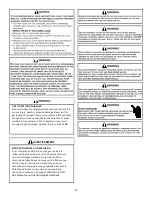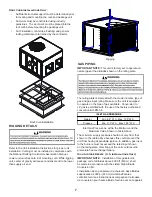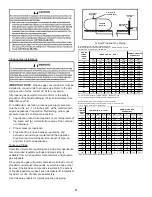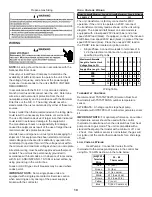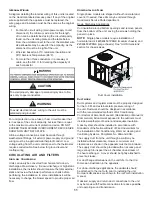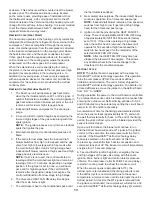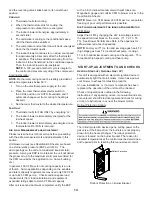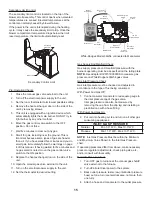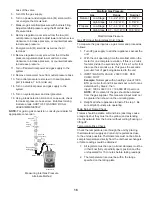
8
The gas/electric units naturally derate with altitude. Do
not attempt to increase the firing rate by changing orifices
or increasing the manifold pressure. This can cause poor
combustion and equipment failure. At all altitudes, the
manifold pressure must be within 0.3 inches W.C. of that
listed on the nameplate for the fuel used. At all altitudes
and with either fuel, the air temperature rise must be within
the range listed on the unit nameplate.
Refer to the Installation Manual provided with the LP kit for
conversion from natural gas to propane gas and for altitude
adjustments.
Use HA02 for installations above 2000’.
NOTE:
Up to 2,000 feet, no changes are required;
above 2,000 feet, refer to the gas/electric package unit
specification sheets for required kit(s).
Piping
IMPORTANT NOTE
: To avoid possible unsatisfactory
operation or equipment damage due to under firing of
equipment, do not undersize the natural/propane gas piping
from the meter/tank to the unit. When sizing a trunk line,
include all appliances on that line that could be operated
simultaneously.
The rating plate is stamped with the model number, type of
gas and gas input rating. Make sure the unit is equipped
to operate on the type of gas available. The gas line
installation must comply with local codes, or in the absence
of local codes, with the latest edition of the National Fuel
Gas Code NFPA 54/ANSI Z223.1.
Natural Gas Connection
Refer to the Proper Piping Practice drawing for the general
layout at the unit. The following rules apply:
1. Use black iron pipe and fittings for the supply piping.
The use of a flex connector and/or copper piping is
permitted as long as it is in agreement with local
codes.
2. Use pipe joint compound on male threads only. Pipe
joint compound must be resistant to the action of the
fuel used.
3. Use ground joint unions.
4. Install a drip leg to trap dirt and moisture before it can
enter the gas valve. The drip leg must be a minimum
of three inches long.
5. Use two pipe wrenches when making connection to
the gas valve to keep it from turning.
6. Install a manual shut-off valve in a convenient
location (within six feet of unit) between the meter
and the unit.
7. Tighten all joints securely.
8. The unit must be connected to the building piping by
one of the following methods:
• Rigid metallic pipe and fittings
• Semirigid metallic tubing and metallic fittings
(Aluminum alloy tubing must not be used in
exterior locations)
• Listed gas appliance connectors used in
accordance with the terms of their listing that are
completely in the same room as the equipment
In the preceding two methods the connector or tubing must
be protected from physical and thermal damage. Aluminum
alloy tubing and connectors must be coated to protect
against external corrosion when in contact with masonry,
plaster or insulation or are subject to repeated wettings by
liquids (water - not rain water, detergents or sewage).
Length of
Pipe in Feet
1/2
3/4
1
1 1/4
1 1/2
10
132
278
520
1050
1600
20
92
190
350
730
1100
30
73
152
285
590
980
40
63
130
245
500
760
50
56
115
215
440
670
60
50
105
195
400
610
70
46
96
180
370
560
80
43
90
170
350
530
90
40
84
160
320
490
100
38
79
150
305
460
Pressure = .50 PSIG or less and Pressure Drop of 0.3" W.C. (Based
on 0.60 Specific Gravity Gas)
Natural Gas Capacity of Pipe
in Cubic Feet of Gas Per Hour (CFH)
Nominal Black Pipe Size (inches)
BTUH Furnace Input
Heating Value of Gas (BTU/Cubic Foot)
CFH =
Proper Piping Practice
NOTE:
The unit gas supply entrance is factory sealed with
plugs. Keep plugs in place until gas supply is ready to be
installed. Once ready, replace the plugs with the supplied
grommets and install gas supply line.
There will be air in the gas supply line after testing for leaks
on a new installation. Therefore, the air must be bled from
the line by loosening the ground joint union until pure gas
is expelled. Tighten union and wait for five minutes until all
gas has been dissipated in the air. Be certain there is no
open flame in the vicinity during air bleeding procedure.
The unit is placed in operation by closing the main electrical
disconnect switch for the unit.
Piping
Summary of Contents for APD 14 M Series
Page 23: ...23 UNIT DIMENSIONS...



